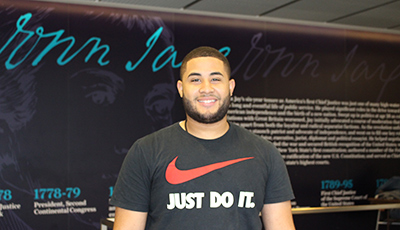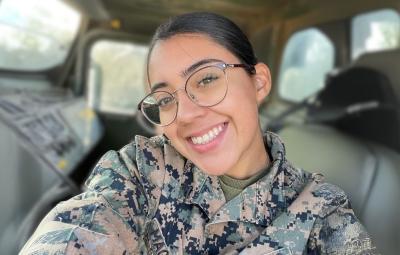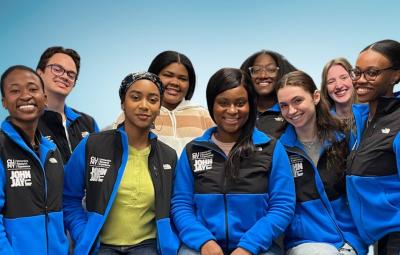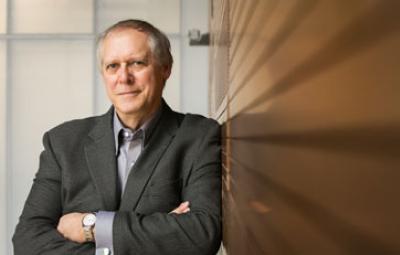
The idea that police officers could benefit substantially from a college education is hardly a new one. In fact, it is the very reason John Jay College came into being in 1964. But for a long time, most John Jay students were cops during the day and students at night; they were established police officers earning degrees during their spare time. What the Cadet Corps sought to establish was the reverse: a program that would create a channel for college students to join the police department. To date it has been responsible for putting 3,503 college-educated police officers on the streets of New York. Unsurprisingly, John Jay students contribute significantly to the ranks of the NYPD Cadet Corps, numbering 364 students this year, or 61 percent of all cadets.
John Reynoso is a cadet and John Jay student in his senior year, and currently works at the 46th precinct in the Bronx as a telephone switchboard operator. Previously he worked with the Special Victims Unit in Manhattan. "It’s definitely exciting," he said. "As a cadet, you get to see a lot of what goes on in the precinct. Another perk is you get priority to come back [to the precinct] if you make the right connections."
Reynoso put his finger on another major goal of the program: "The police community and the communities they serve don’t have the best relationship," he said. "There isn’t much understanding between them. I definitely want to help change that, and I feel like if the right people get hired it can really make a difference."
Rosemary Gallardo, a cadet in her junior year with a background in volunteer work, joined the Cadet Corps through Apple Corps, another program at John Jay that provides a wide array of benefits to freshmen and sophomore students interested in becoming police officers. She said she joined because she’s always loved serving her community. "You really get to see behind the scenes of what it’s like interacting with officers. They’re not how the media portrays them," she said, "they’re really nice and will help you in anything you ask them to."
Gallardo said she hopes to work as a detective or with a canine unit. “The discipline they give you helps improve your skills all around,” she added.
What is today a robust and thriving program began as a memo entitled "A Third Option," sent by former John Jay President Jeremy Travis, then Special Counsel to the Police Commissioner, to Commissioner Ben Ward in July of 1985. Mayor Ed Koch had been pressuring the police department to up recruitment levels and increase diversity among officers, and there was a big debate among those involved on just how to do it. Travis was given the task of advising the mayor on the competing ideas, and he helped lay out a new idea where students in their junior or senior years would be offered a $2000 stipend in addition to having their tuition covered to serve as a police cadet working as an aid to a community patrol officer.
The idea won the favor of Commissioner Ward and Mayor Koch, and was soon put into action. But during the 2000s the program was cut drastically as a way to save money. As recently as 2014, there were just 107 spots in the entire program. This was not due to lack of interest or applicants, but simply lack of funds.
According to First Deputy Commissioner and John Jay alumnus Benjamin Tucker, "The only obstacle to getting people to come in was that the headcount was maxed out at 107. So we lobbied for the funding with the mayor, and said 'we really ought to think about seriously getting this back up and running.'"
Tucker, along with Inspector Michael McGrath, who was part of the training bureau at the time and is now Commanding Officer of the Cadet Corps, lobbied Mayor Bill de Blasio's office, which eventually restored funding for the program. Today, the budgeted headcount is back up to 635. “And just about 5 months ago we had maxed out all 635 of those slots,” said Tucker. Of those slots, more than half are John Jay students.
One reason Tucker was adamant to get Cadet Corps back to full capacity is that officers who come up through Cadet Corps often go on to achieve high ranks and hold long, successful careers with the NYPD. In other words, cadets make great cops. 82 former cadets have currently achieved the rank of captain or above including 46 captains, 18 deputy inspectors, 10 full inspectors, 4 deputy chiefs, and 4 assistant chiefs.
"It's not just a career path for the purpose of entry level – it has proven itself to be a very effective motivator for young people to take promotional exams and to excel in that regard," Tucker said. "It suggests that you’ve got some stellar people who came in because of that experience early-on, and it helped motivate them up through the ranks."
In addition to being a career path, Cadet Corps also provides flexible, paid employment for college students who might otherwise be forced to choose between work and studying.
Said Reynoso, "You don’t even have to become a police officer – you can pursue a career, or use it as a job experience. I definitely recommend the program to anybody."



